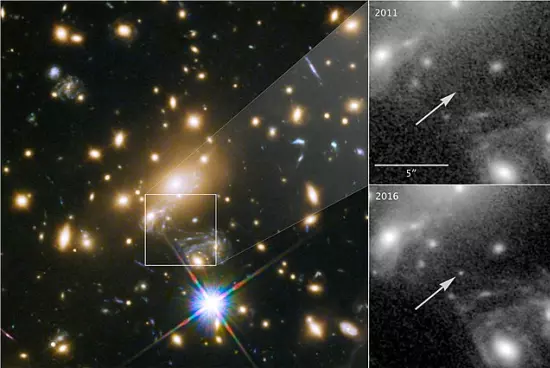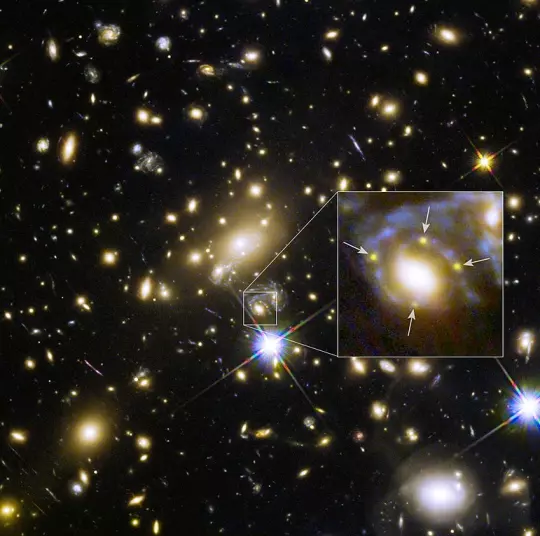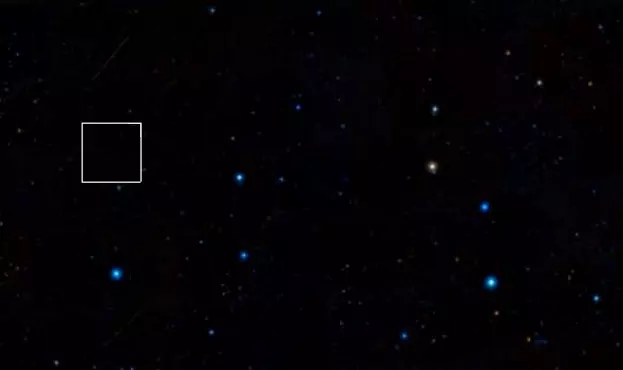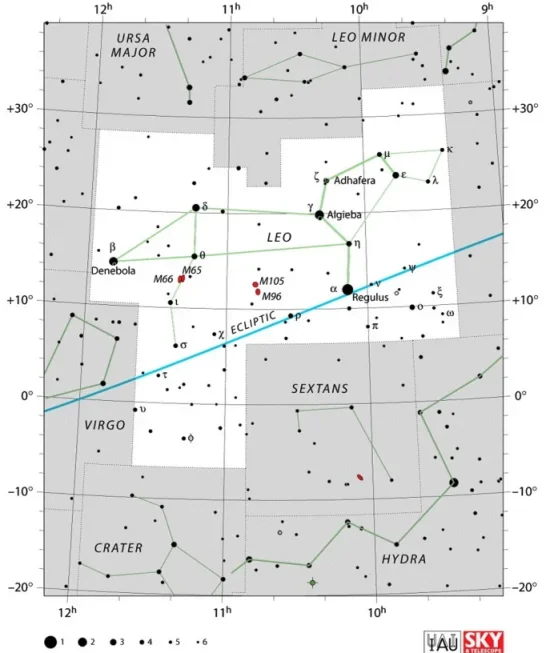Icarus (MACS J1149 Lensed Star 1) is a blue supergiant discovered through a gravitational lens in 2018. It is the second most distant individual non-supernova star known, after Earendel (WHL0137-LS), discovered in March 2022. Icarus lies at a distance of 14.4 billion light years from Earth. It is at least a hundred times more distant than the previous record-holder, the O-type supergiant SDSS J1229+1122.
Icarus normally has an apparent magnitude of 29.9 and is far too faint to be spotted even in the largest telescopes. However, NASA’s Hubble Space Telescope was able to capture the star through a gravitational lens – a massive foreground galaxy cluster – that magnified it more than 2,000 times. The cluster, named MACS J1149+2223, lies about 5 billion light-years from Earth, between us and the distant spiral galaxy that harbours Icarus.
Gravitational lensing
Gravitational lensing is a phenomenon that occurs when light from a background object is bent by a massive object as it travels from the source to the observer. In the case of Icarus, gravity from the foreground galaxy cluster MACS J1149+2223 acts as a natural lens, a magnifying glass that bends the light of the faraway star and other distant objects in the background and amplifies their brightness.

This image composite shows the discovery of the most distant known star using the NASA/ESA Hubble Space Telescope. The image to the left shows a part of the the deep-field observation of the galaxy cluster MACS J1149.5+2223 from the Frontier Fields programme gathered in 2014. The square indicates the position where the star appeared in May 2016 — its image magnified by gravitational microlensing. This part of the image also shows the four images of the Refsdal supernova, arranged in an Einstein cross. The upper right image pinpoints the position of the star, observed in 2011. The lower right image shows where the star was undergoing the microlensing event in late May 2016. Image: NASA & ESA and P. Kelly (University of California, Berkeley)
A single gravitationally lensed background object can appear in multiple images around the foreground cluster. Multiple images of a lensed object that appear in a cross-shaped pattern are known as an Einstein cross. If the object, the lens, and the observer are in perfect alignment, the light may also appear as a ring (an Einstein ring).
With Icarus, modelling suggests that the star’s light was amplified by about 600 times by the galaxy cluster MACS J1149+2223 and that the brightening was additionally amplified by an object in the cluster with a mass similar to the Sun, that moved in front of Icarus. When a star’s light is so highly magnified, the star becomes bright enough to be detected by Hubble.
Dark matter
Observations of Icarus with the Hubble Space Telescope over the course of 13 years gave scientists an opportunity to study the nature of dark matter in the galaxy cluster. Astronomers observed the objects floating around the foreground cluster to test the hypothesis that dark matter may primary be made of many primordial black holes, formed when the universe was born, with masses tens of times that of the Sun. The study of Icarus proved the theory of dark matter unlikely because the light fluctuations of the star did not indicate the presence of a multitude of black holes.
Star type
Icarus is a blue supergiant star of the spectral type B with a surface temperature between 11,000 and 14,000 K. Class B stars are exceptionally massive and luminous. They do not live very long lives. Due to their high mass, they burn through the hydrogen in the cores in only millions of years and evolve away from the main sequence.
The light of Icarus visible in the Hubble images was emitted 9.34 billion years ago. The lookback time is different from the distance (14.4 billion light-years) due to the expansion of the universe during the time that it took the star’s light to reach us. This means that the light was emitted 4.4 billion years after the Big Bang.
While Sun-like stars have a lifespan of 10 billion years, B-type stars spend only about 100 million years on the main sequence before evolving into giants or supergiants. This means that Icarus is long gone, and the Hubble images show it as it was when the universe was only three-quarters of its current age.
Faraway stars in the early universe like Icarus will be much easier to track down with NASA’s James Webb Space Telescope, launched on Christmas Day in 2021. The telescope will allow astronomers to study distant stars in even more detail, including their rotation, and to find the earliest stars in the universe. It will also allow scientists to study variable stars and supernovae in young galaxies.
Facts
The discovery of Icarus was first reported in a study led by Patrick Kelly (University of Minnesota), published in the journal Nature Astronomy in 2018. The team that discovered the star also included Jose Diego of the Instituto de Física de Cantabria, Spain, Alex Filippenko of University of California, Berkeley, and Steven Rodney of the University of South Carolina, Columbia.
The researchers discovered an image of a star at redshift z=1.49, magnified by >2,000. They nicknamed the star MACS J1149 Lensed Star 1 (LS1). The team reported a separated image 0.26 arcseconds away, believed to be a counterimage of the star demagnified for multiple years by a solar-mass object with a mass of up to 3 solar masses in the galaxy cluster.
The solar-mass object, which could have been a star, a neutron star or a stellar-mass black hole, produced an effect known as gravitational microlensing as it passed through the line of sight. The microlensing event amplified the image by an additional factor of about 4 and peaked in May 2016. A second peak near the maximum indicated that the star may be a binary system.
The researchers inferred that the star was not a supernova from the fact that it was not getting hotter. Even though it got three times brighter in a single month, the colour of its light did not change. Analysis of the colour led the team to conclude that the star was a blue supergiant. The temperature allowed them to identify its spectral type (B).
The team discovered Icarus in 2016, while observing the supernova SN Refsdal, the first-ever multiply lensed supernova detected. Like Icarus, the supernova lay in the field of the MACS J1149+2223 galaxy cluster, not far from the star. Four images of the supernova were arranged as an Einstein cross. The supernova was named after the Norwegian astrophysicist Sjur Refsdal, known for his work on gravitational lensing. In 1964, Refsdal was the first to propose that time-delayed images of a lensed supernova may be used to estimate the expansion rate of the universe. The astronomers studying the supernova discovered a new point of light in the same area and, after analyzing Hubble images, found it to be an individual normal star that set a new distance record.

This image shows the huge galaxy cluster MACS J1149+2223, whose light took over 5 billion years to reach us. The huge mass of the cluster and one of the galaxies within it is bending the light from supernova SN Refsdal behind them and creating four separate images of it. The light has been magnified and distorted due to gravitational lensing and as a result the images are arranged around the elliptical galaxy in a formation known as an Einstein cross. A close-up of the Einstein cross is shown in the inset. Image: NASA, ESA, S. Rodney (Johns Hopkins University, USA) and the FrontierSN team; T. Treu (University of California Los Angeles, USA), P. Kelly (University of California Berkeley, USA) and the GLASS team; J. Lotz (STScI) and the Frontier Fields team; M. Postman (STScI) and the CLASH team; and Z. Levay (STScI)
Name
MACS J1149 Lensed Star 1 was nicknamed Icarus by the team of astronomers who discovered it. In Greek mythology, Icarus flew too close to the Sun with wings constructed from feathers and wax, fell into the sea, and drowned. Like the mythological character, the star had a fleeting moment of glory when it was briefly magnified. For the same reason, the co-discoverer Patrick Kelly had initially suggested the name Warhol, in reference to Andy Warhol’s quote about 15 minutes of fame.
The star’s official name, MACS J1149 Lensed Star 1 (MACS J1149 LS1) or MACS J1149+2223 Lensed Star 1, refers to the MAssive Cluster Survey (MACS) of massive clusters of galaxies and the coordinates of the star in the J2000 astronomical epoch.
Location
Icarus lies in the eastern part of the constellation Leo, in the region above the Lion’s tail, near the border with Coma Berenices. At magnitude 29.9, the star cannot be seen in amateur telescopes. It would be invisible even to Hubble without the gravitational lensing.

Icarus location, image: Wikisky
Constellation
Icarus is located in the constellation Leo. The zodiacal Lion occupies 947 square degrees of the northern sky and is the 12th largest of the 88 constellations. It was first listed by the Greco-Roman astronomer Ptolemy of Alexandria in his Almagest in the 2nd century CE, along with other Greek constellations. Leo is associated with the Nemean lion, a vicious monster that met its end at the hands of Heracles in Greek mythology.
Leo contains many notable stars, among them Regulus (Alpha Leonis), the 21st brightest star in the sky, the white supergiant Eta Leonis, the nearby red dwarf Wolf 359, the carbon star CW Leonis, and Caffau’s Star, one of the oldest stars in our galaxy, with an estimated age of 13 billion years.

Leo constellation map by IAU and Sky&Telescope magazine
Bright deep sky objects in Leo include the Leo Triplet of galaxies – Messier 65, Messier 66 and Sarah’s Galaxy (NGC 3628) – and the Leo I Group, which includes the galaxies Messier 95, Messier 96, and Messier 105. The constellation is also home to the Cosmic Horseshoe, a gravitationally lensed system of two galaxies lying 5.3 and 10.3 gigalight years away, the protoplanetary nebula known as the Frosty Leo Nebula, the Owl Galaxy (NGC 3758), and the Silverado Galaxy (NGC 3370).
The best time of year to observe the stars and deep sky objects in Leo is in April, when the constellation is prominent in the evening sky. The entire constellation is visible from locations between the latitudes 90° N and 65° S.
The 10 brightest stars in Leo are Regulus (Alpha Leo, mag. 1.40), Algieba (Gamma Leo, mag. 2.08), Denebola (Beta Leo, mag. 2.113), Zosma (Delta Leo, mag. 2.56), Epsilon Leonis (mag. 2.98), Chertan (Theta Leo, mag. 3.324), Adhafera (Zeta Leo, mag. 3.33), Eta Leonis (mag. 3.486), Subra (Omicron Leo, mag. 3.52), and Shaomin (Rho Leo, mag. 3.9).
Icarus – MACS J1149 LS1
| Spectral class | B |
| Apparent magnitude (V) | ≈28.4 (normally 29.9) |
| Apparent magnitude (R) | ≈28.2 (normally 29.7) |
| Apparent magnitude (Z) | ≈27.9 (normally 29.4) |
| Apparent magnitude (J) | 27.3 (normally 28.8) |
| Apparent magnitude (H) | 27.4 (normally 28.9) |
| Distance | 14.4 billion light years |
| Temperature | 11,000 – 14,000 K |
| Metallicity | ≈0.006 |
| Age | ~8 million years |
| Surface gravity | 2 – 4 cgs |
| Constellation | Leo |
| Right ascension | 11h 49m 35.59s |
| Declination | 22° 23′ 47.4″ |
| Names and designations | Icarus, MACS J1149 Lensed Star 1, MACS J1149 LS1, MACS J1149+2223 Lensed Star 1, LS 1 |